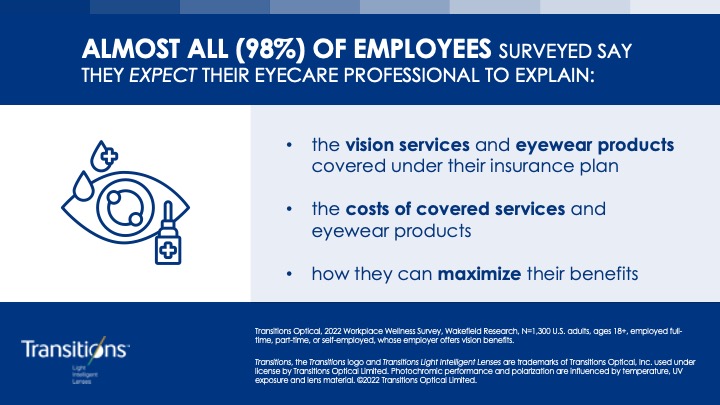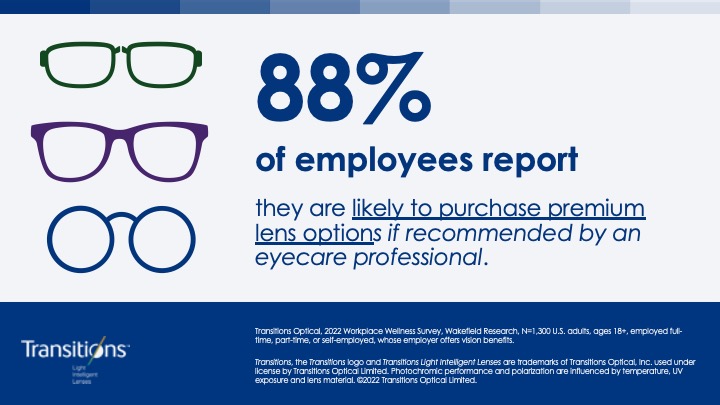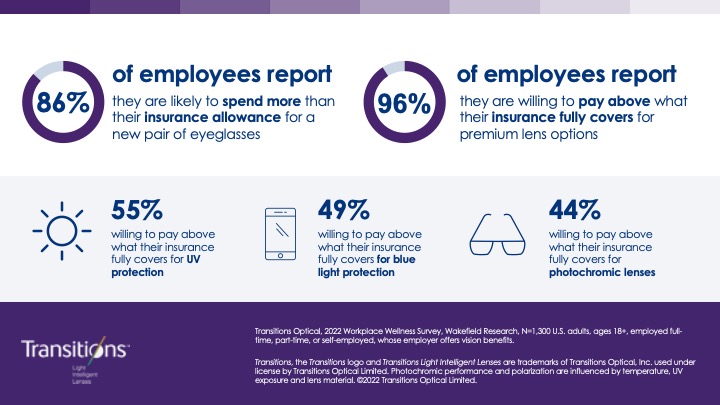In the eyes of the employee, eye care professionals (ECPs) are expected to educate them on their vision insurance plan’s benefits—according to the 2022 Transitions Optical Workplace Wellness survey[1]. Employees also prefer to receive their benefit information from an ECP versus their insurance provider.


EXPECTATIONS
Almost all (98 percent) employees surveyed say they expect their ECP to explain:
- the vision services and eyewear products covered under their insurance plan
- the costs of covered services and eyewear products
- how they can maximize their benefits
In contrast to the many employees who expect their ECP to explain their coverage benefits, only three in 10 (31 percent) employees prefer to access their benefit information through their vision insurance plan’s website. Even fewer (28 percent) prefer to access their benefit information during open enrollment.
“Employees put a lot of trust in their ECP, and our survey findings reinforce the need for them to be aware of new employee expectations,” said Jonathan Ormsby, senior key account manager, Transitions Optical, “This is an opportunity to provide employees with exactly what they are looking for from an ECP, which can help a practice truly stand out.”
ECP RECOMMENDATIONS CAN INFLUENCE PURCHASING DECISIONS
Light sensitivity and digital eyestrain can lead to many problems for employees while at work, ranging from trouble seeing, to headaches, to even taking excessive breaks. The 2022 Workplace Wellness survey found that 78 percent of employees report their work productivity and performance has been impacted by either eyestrain/eye fatigue (50 percent), headaches (39 percent), blurry vision (36 percent), discomfort looking at bright screens (33 percent), and/or difficulty focusing on distance objects upon looking up from the screen (33 percent). Additionally, in 2020, a Transitions Optical survey found 67 percent of employees take breaks throughout the day to help alleviate discomfort from sitting behind a screen[2].


In a time of increased demands on employees’ eyes, ECP recommendations can influence purchasing decisions—even without them considering the financial cost. In fact, 88 percent of employees report they are likely to purchase premium lens options if recommended by an ECP. Additionally, 86 percent of employees are also likely to spend more than their insurance allowance for a new pair of eyeglasses, and almost all (96 percent) of the employees surveyed report they are willing to pay above what their insurance fully covers for premium lens options including:
- 55 percent willing to pay above what their insurance fully covers for UV protection
- 49 percent willing to pay above what their insurance fully covers for blue light protection
- 44 percent willing to pay above what their insurance fully covers for photochromic lenses


“It is more important than ever for ECPs to be aware of patient desires and needs, especially in the digital age, when it comes to recommending premium lens options,” said Ormsby. “Our research aims to help ECPs so they can provide solutions to employees that work with their modern lifestyles and help them to see their best in any light condition.”
About the Transitions® Brand
Transitions® eyeglass lenses and shields set new standards of advanced performance to provide ever increasing visual comfort and optimum harmful blue light protection, and always blocking 100 percent of UVA and UVB rays. Product leadership, consumer focus, and operational excellence have made the Transitions® brand one of the most recognized consumer brands in optics. For more information about Transitions® Light Intelligent Lenses™, visit Transitions.com or TransitionsPRO.com.
[1] Transitions Optical, 2022 Workplace Wellness Survey, Wakefield Research, N=1,300 U.S. adults, ages 18+, employed full-time, part-time or self-employed, whose employer offers vision benefits.
[2] Transitions Optical, 2020 Workplace Wellness Survey, Wakefield Research, N=1,300 U.S. adults, ages 18+, employed full-time or part-time, whose employer offers vision benefits.



